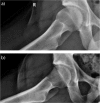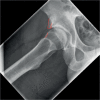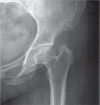Impingement around the hip: beyond cam and pincer
- PMID: 29657843
- PMCID: PMC5890128
- DOI: 10.1302/2058-5241.3.160068
Impingement around the hip: beyond cam and pincer
Abstract
In this review, we bring to the attention of the reader three relatively unknown types of hip impingement. We explain the concept of low anterior inferior iliac spine (AIIS) impingement, also known as sub-spine impingement, ischio-femoral impingement (IFI) and pelvi-trochanteric impingement. For each type of impingement, we performed a search of relevant literature.We searched the PubMed, Medline (Ovid) and Embase databases from 1960 to March 2016. For each different type of impingement, a different search strategy was conducted.In total, 19 studies were included and described. No data analysis was performed since there was not much comparable data between studies.An overview of symptoms, clinical tests and possible surgical treatment options for the three different types of extra-articular impingement is provided.Several disorders around the hip can cause similar complaints. Therefore, we plead for a standardized classification. In young and athletic patients, in particular, there is much to gain if hip impingement is diagnosed early. Cite this article: EFORT Open Rev 2018;3:30-38. DOI: 10.1302/2058-5241.3.160068.
Keywords: arthroscopy; hip; impingement.
Conflict of interest statement
ICMJE Conflict of interest statement: Daniel Haverkamp declares consultancy for Arthrex, IMove, Implantcast, Mathys, Medichanical and Alphamed, activities outside the submitted work.
Figures






References
-
- Burman MS. Arthroscopy or the direct visualization of joints. An experimental cadaver study. J Bone Joint Surg 1931;13A:669-695. - PubMed
-
- Ganz R, Bamert P, Hausner P, Isler B, Vrevc F. [Cervico-acetabular impingement after femoral neck fracture]. Unfallchirurg 1991;94:172-175. - PubMed
-
- Polat G, Dikmen G, Erdil M, Aşık M. Arthroscopic treatment of femoroacetabular impingement: early outcomes. Acta Orthop Traumatol Turc 2013;47:311-317. - PubMed
-
- Crawford JR, Villar RN. Current concepts in the management of femoroacetabular impingement. J Bone Joint Surg [Br] 2005;87:1459-1462. - PubMed
-
- Tönnis D, Heinecke A. Acetabular and femoral anteversion: relationship with osteoarthritis of the hip. J Bone Joint Surg [Am] 1999;81:1747-1770. - PubMed
LinkOut - more resources
Full Text Sources
Other Literature Sources

